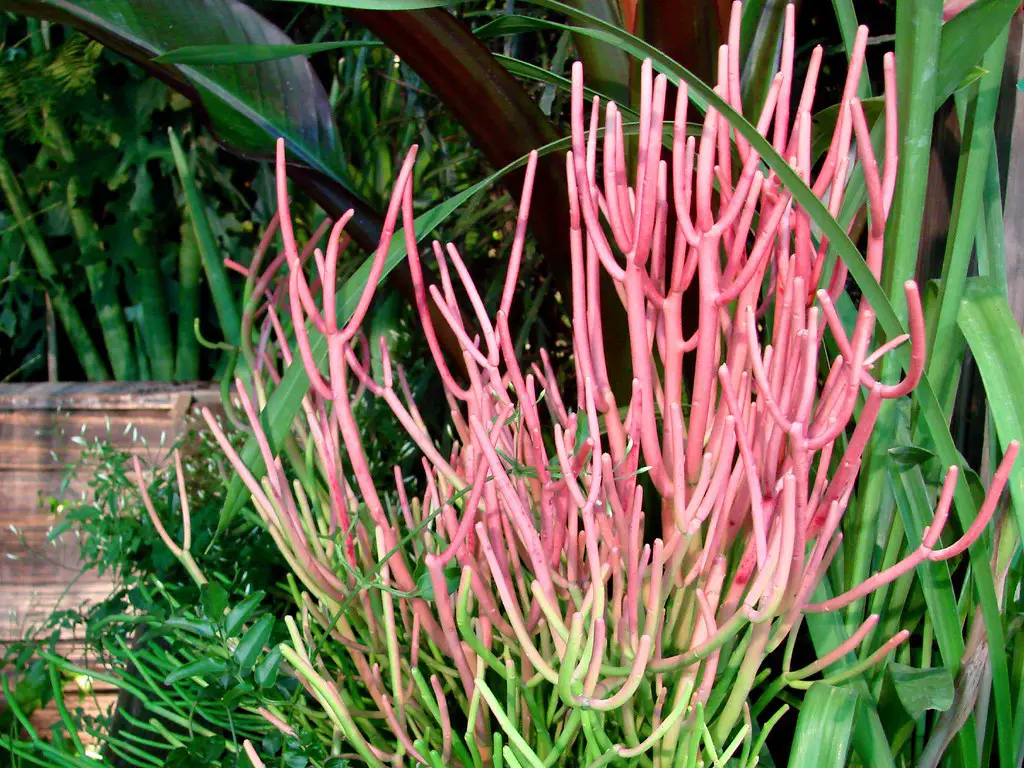The Pencil Cactus, also known as Euphorbia tirucalli, is a striking succulent that is native to Africa. Despite its name, the Pencil Cactus is not a true cactus but belongs to the Euphorbia genus. Its appearance is unique, with pencil-thin stems that grow in a dense, bush-like fashion. The plant can vary in color, with green to yellowish stems that may turn reddish in bright sunlight.
Renowned for its architectural beauty, the Pencil Cactus has become a popular houseplant. Its sparse, stick-like branches add visual interest and can make a bold statement in various design schemes. However, care should be taken when handling this plant, as its sap can be irritating to the skin and eyes.
In the wild, the Pencil Cactus can grow to an impressive size, and it has been used for various purposes, including hedging and even fuel. As a houseplant, it can be maintained at a smaller size and offers an easy-care option for those looking to add an exotic flair to their indoor garden.
| Aspect | Details |
|---|---|
| Common Names | Pencil Cactus, Stick Plant, Firestick |
| Botanical Name | Euphorbia tirucalli |
| Family | Euphorbiaceae |
| Plant Type | Succulent |
| Mature Size | 4-6 feet indoors, 30 feet outdoors |
| Sun Exposure | Full Sun to Partial Shade |
| Soil Type | Well-drained, Sandy Soil |
| Hardiness Zones | 10-11 |
| Native Area | Africa |
Pencil Cactus Care
The care of Pencil Cactus is relatively straightforward and suits even those with less green thumbs. It thrives in sunny environments and requires minimal watering, following the typical care pattern for many succulents. One critical consideration is to avoid any contact with the plant’s milky sap, which can be irritating.
Being a drought-tolerant plant, Pencil Cactus can survive periods of neglect. However, proper watering, sunlight, and occasional fertilizing will keep the plant healthy and vibrant. It’s a rewarding addition to a houseplant collection, offering both aesthetic appeal and low maintenance.
Light Requirement for Pencil Cactus
Pencil Cactus appreciates bright light and will thrive in a location that receives full sun to partial shade. If kept indoors, placing it near a south-facing window will ensure ample sunlight. Insufficient light can lead to leggy growth and reduced color intensity.
Soil Requirements for Pencil Cactus
A well-drained soil mix specifically designed for succulents or cacti is ideal for Pencil Cactus. Regular potting soil can be made suitable by adding sand or perlite to enhance drainage. Good drainage is vital to prevent root rot, which is a common issue with succulents.
Water Requirements for Pencil Cactus
Being a succulent, Pencil Cactus has low water requirements. Watering should be done sparingly and allowed to dry between watering. Overwatering can lead to root rot, so it’s crucial to follow a less-is-more approach and ensure that the pot has drainage holes.
Temperature and Humidity
Pencil Cactus enjoys warm temperatures and can tolerate dry air. It prefers temperatures above 50°F (10°C) and can be placed outdoors in summer if desired. Avoid cold drafts and sudden temperature changes, as these can cause stress to the plant.
Fertilizer
Fertilize Pencil Cactus sparingly using a balanced liquid fertilizer designed for cacti or succulents. Feeding once in the growing season, typically in spring or early summer, will suffice.
Pruning Pencil Cactus
Pruning can be done to maintain shape or remove any damaged parts. Use caution when pruning, as the sap can irritate the skin. Wearing gloves and using clean, sharp tools will help in the process. Make cuts at joints to promote healthy growth.
Propagating Pencil Cactus
Propagating Pencil Cactus is straightforward and can be done through stem cuttings. Allow the cut stem to dry for a few days to form a callus before planting in a well-drained soil mix. Handle with care to avoid contact with the sap.
How To Grow Pencil Cactus From Seed
Growing Pencil Cactus from seed is a more complicated process and usually reserved for enthusiasts or specialized growers. Seeds can be sown in a well-draining soil mix and require consistent warmth and controlled conditions to germinate successfully.
Common Pests & Plant Diseases
Mealybugs
Small insects that can be removed manually or treated with insecticidal soap.
Root Rot
Usually a result of overwatering. Ensure proper watering practices and well-drained soil.
Common Problems With Pencil Cactus
Leggy Growth
Often caused by insufficient sunlight. Provide adequate light for compact growth.
Sap Irritation
Avoid contact with the milky sap, as it can cause skin and eye irritation. Handle with care.
Drooping Stems
May indicate overwatering or a root problem. Check the root system and adjust watering accordingly.
Pro Tips
- Use gloves when handling Pencil Cactus to avoid contact with the irritating sap.
- Provide a proper-sized container with drainage holes to prevent waterlogged soil.
- Monitor for pests and treat promptly to avoid infestations.




